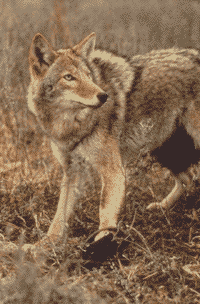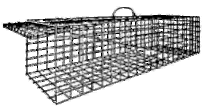Header photo courtesy of Pennsylvania Game Commission
FURBEARER MANAGEMENT IN THE NORTHEAST
CONSERVEWILDLIFE.ORG
TRAP DESIGNS
Today’s traps have been highly refined through extensive testing by the Association of Fish & Wildlife Agencies following rigorous study designs and evaluations in accordance with widely accepted international standards for testing traps. Click here for more information on trap testing and animal welfare. Regulations vary by state on which traps may or may not be used. Please consult the regulations pertaining to your state for current information.
Live-Capture Restraining Devices
|
BOX / CAGE TRAPS are designed to permit entry of an animal through 1-2 doors that then close and prevent the animal from exiting. These traps can be used for multiple terrestrial species that are not averse to entering holes or crevices, but are ineffective for more wary species such as canines. Entry is limited by door size and cage length. They are bulky, heavy to handle and difficult to conceal thereby making them impractical under certain trapping conditions.
CABLE RESTRAINTS, typically constructed of stranded steel wire in various configurations, form a loop that encircles the animal’s body or limb. Non-powered cable restraints use the forward momentum of the animal to place and close the loop. Powered cable devices use a mechanical feature such as a spring to place or close the loop. Entry is limited by loop diameter and height above the ground. They are generally lightweight, easy to handle and conceal, and are effective in both aquatic and terrestrial situations. Cable restraints may also have any of the following components: relaxing-type lock; break-away hook or ferrule; loop stop ferrule(s); in-line swivel; and/or, anchor swivel. Relaxing locks allow the cable loop to draw smaller as the animal pulls but does not continue to close when the pulling ceases. Break-away devices allow large, nontarget animals (deer, bear) to escape if pulled with sufficient force. Loop stops may be used to maintain minimum and/or maximum loop diameters. Swivels prevent the cable from binding or breaking. FOOTHOLD TRAPS have, in most cases, two opposing jaws attached to a baseplate with a pan-trigger device, and designed to hold an animal by gripping the toes or foot across or just above the footpad. Longspring traps are powered by 1-2 springs while the standard coil-spring trap is fitted with 2-4 small springs. In both cases, the spring(s) are released when an animal steps on the trigger pan. Specific species can be targeted based on jaw spread, pan tension and deployment method. Foothold traps are the most commonly used trap type, as they are compact, easy to handle and conceal, and can be used on a myriad of set types on land or in water. Some foothold traps are designed to encapsulate the animal’s foot to eliminate self-directed biting, and some have a bar trigger that is either pulled or pushed for activation. Foot encapsulating traps are highly selective by design (narrow opening, and require some degree of manual dexterity in the target animal when pull activated). |

Foothold traps need not be large to be effective, as demonstrated by this coyote (which was subsequently examined and released). Foothold traps typically capture and hold animals without injury and have been used to capture animals for reintroduction and restoration efforts.
|
Lethal-Capture Devices
Lethal-capture systems are considered to be efficient (animals rarely escape) and humane (loss of consciousness and death are rapid). However, they do not allow for the live release of nontarget animals.
Mechanically powered killing traps, commonly called BODY-GRIP or rotating-jaw traps, are designed to kill an animal quickly when 1-2 rotating jaws close on the animal’s neck or chest, and are powered by one or two springs. They operate in a manner similar to the common mouse trap. Entry is limited by trap opening and trigger configuration and/or placement. Trap weight and handling varies by size, but most are easily concealed. They are most commonly used to capture aquatic furbearers, but are permitted for use in terrestrial sets by some jurisdictions (either directly, elevated and/or recessed within a box).
COLONY TRAPS for muskrat are submerged (entirely or partially, depending on state-specific regulations) cage-type traps having one-way doors on each end providing the option to catch multiple muskrats over time, as opposed to catching a single muskrat with a body-grip trap.
Mechanically powered killing traps, commonly called BODY-GRIP or rotating-jaw traps, are designed to kill an animal quickly when 1-2 rotating jaws close on the animal’s neck or chest, and are powered by one or two springs. They operate in a manner similar to the common mouse trap. Entry is limited by trap opening and trigger configuration and/or placement. Trap weight and handling varies by size, but most are easily concealed. They are most commonly used to capture aquatic furbearers, but are permitted for use in terrestrial sets by some jurisdictions (either directly, elevated and/or recessed within a box).
COLONY TRAPS for muskrat are submerged (entirely or partially, depending on state-specific regulations) cage-type traps having one-way doors on each end providing the option to catch multiple muskrats over time, as opposed to catching a single muskrat with a body-grip trap.
Choosing the Appropriate System
The choice of trap system depends on the furbearer targeted, the specific situation, the type of trap employed and trap modifications – the right tool for the right job is needed. For example, cage traps are an excellent choice for opossum, raccoon and skunk when trapping near residential areas in wildlife damage management situations, but may not be the best trap choice for these species in remote locations. Also, some animals are too wary to enter a cage trap.
All traps need to be anchored in some way, and the anchoring system should always be strong enough to hold the largest furbearer that might be captured. The anchoring system of most restraining devices should include one or more swivels (including one at the anchor point) to minimize injury to the animal, reduce fur damage, and in the case of cable restraints, prevent breakage.
Several BMP foothold traps are conventional models that have been modified to improve animal welfare. Such modifications include: padding, laminating or offsetting the jaws; adding extra springs, using pan-stops or reinforcing the base plate.
Submersion trapping systems are frequently used for aquatic or semi-aquatic furbearers found in or near waterways. Such systems consist of traps (body-grip, cage, cable devices or footholds of appropriate size and weight), equipment and techniques that allow or cause an animal, when trapped, to quickly and irreversibly submerge until death occurs. Traps are set underwater at a depth that prevents the animal from reaching the surface, or they set in shallow water near shore and attached with a one-way sliding lock to a cable anchored in deep water. The terminal end of the anchoring system must be deep enough to keep the animal underwater.
All traps need to be anchored in some way, and the anchoring system should always be strong enough to hold the largest furbearer that might be captured. The anchoring system of most restraining devices should include one or more swivels (including one at the anchor point) to minimize injury to the animal, reduce fur damage, and in the case of cable restraints, prevent breakage.
Several BMP foothold traps are conventional models that have been modified to improve animal welfare. Such modifications include: padding, laminating or offsetting the jaws; adding extra springs, using pan-stops or reinforcing the base plate.
- Offset Jaws – contain a space between the gripping surfaces on the closed jaws. This allows spring levers or spring eyes to close higher upon capture, reducing likelihood of escape; and, clamping pressure is slightly reduced when levers are fully raised which may improve animal welfare under some conditions.
- Double Jaws – decreases the distance between the jaw and trap pan, limiting access to the restrained foot thereby reducing the likelihood of self-directed biting.
- Lamination & Padding – expand jaw thickness and increases surface area of the jaw on the animal’s foot, and may influence both animal injury and capture efficiency.
- Additional Springs – can increase trap performance and capture rate. Adding two extra coils to foothold traps (i.e., four-coiling) also makes the trap more stable when bedded.
- Pan Stops – ensure optimal jaw placement on the restrained foot and reduce the likelihood of self-directed biting by decreasing the distance between jaws and pan after capture.
- Reinforced Base Plates – strengthen the trap frame and prevent bending, and can also be used for center swivel attachment point.
Submersion trapping systems are frequently used for aquatic or semi-aquatic furbearers found in or near waterways. Such systems consist of traps (body-grip, cage, cable devices or footholds of appropriate size and weight), equipment and techniques that allow or cause an animal, when trapped, to quickly and irreversibly submerge until death occurs. Traps are set underwater at a depth that prevents the animal from reaching the surface, or they set in shallow water near shore and attached with a one-way sliding lock to a cable anchored in deep water. The terminal end of the anchoring system must be deep enough to keep the animal underwater.


